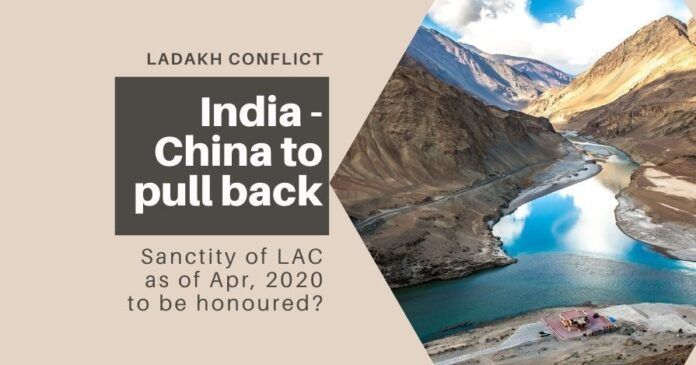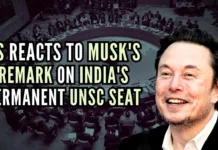
India and China may agree to three step process of disengaging from LAC
After a six-month-long tussle on border issues and after series of top-commander level talks, India and China are expected to agree on disengaging from the Line of Actual Control (LAC) areas by withdrawing tanks and heavy tanks from the stand-off sites. According to highly placed sources, this disengagement will be in a phased manner by mutual verification on others’ deployment and its withdrawals by thinning out the troops at the sensitive areas where stand-off is being witnessed.
The agreement on disengagement on both sides is expected to be materialised in the ninth round of Corps Commander level talks in the next few days, sources said here on Wednesday. At present eight commander-level talks happened between India and China after the Galwan incident where both sides faced severe causalities of soldiers. Indian side faced the death of 22 soldiers and according to foreign media’s estimates, the Chinese side faced more than 40 soldiers’ deaths. Indian Army Chief General M M Naravane had hinted on Tuesday that “we are hopeful that we will be able to reach an agreement which is mutually acceptable and mutually beneficial.” His observations came days after the Corps Commanders of India and China held the eighth round of parleys at Chushul, Ladakh on November 6.
India and China may agree to a three-step-process, broadly agreeing on disengagement of troops and withdrawal of weaponry from all major friction points in a time-bound manner.
Naravane said the senior military commanders of India and China are “ironing out the modalities” of how to proceed ahead. “We had the 8th round of talks on November 6 between the highest military level commanders on both sides. They are ironing out the modalities of how to proceed ahead within the overarching guidelines which had been communication post the interactions and the meetings between the respective Ministers (defence and foreign),” the Army chief had said.
India and China may agree to a three-step-process, broadly agreeing on disengagement of troops and withdrawal of weaponry from all major friction points in a time-bound manner. However, key officials said these were proposals and no agreement has been inked so far. The proposal of disengagement includes removal of armoured personnel carriers within one day of inking an agreement, withdrawal of troops from specific areas on the north and south banks of the Pangong lake in Eastern Ladakh, and carrying out verification of the disengagement process by both sides, they said.
The specific proposals for the disengagement and restoration of the status quo ante as existed in April were finalised during the eighth round of high-level military talks, they said. As a first step, both sides will remove their tanks, artillery guns, armoured vehicles, and large equipment from the stand-off points along the LAC to their rear bases within three days of inking the agreement.
The second step proposes the Chinese army will go back to Finger 8 areas from their current position of Finger 4 on the north bank of Pangong lake while the Indian troops would position themselves close to the Dhan Singh Thapa post. The mountain spurs in the area are referred to as Fingers. It was broadly agreed to withdraw around 30 percent of the troops every day for three days, they said.
In the third step, it was agreed to complete the disengagement process in areas along the southern bank of Pangong lake like Rezang La, Mukhpari, and Magar hill. After this, both sides will carry out a detailed verification process following which normal patrolling is expected to resume.
- NIA confiscates Pak-harboured Khalistani terrorist Lakhbir Singh Rode’s key aide’s land in Moga - April 19, 2024
- Prime Minister Narendra Modi: A Gujju businessman who does not invest his precious time for a losing battle - April 13, 2024
- NIA arrests two accused Shazib and Taahaa in Bengaluru’s Rameshwaram Cafe blast case from Kolkata - April 12, 2024











[…] India and china expected to agree for disengagement of troops, heavy tanks, and artilleries from sta… – Nov 12, 2020, […]
[…] India and China fought a war in 1962, and then faced off again just months ago. Now the two sides are in talks to deescalate the situation, with a plan on the table to pull back military […]
[…] खबर को अंग्रेजी में यहाँ […]
Why can’t India demand the compensation of expenses incurred for war preparedness as the conditions were thrust on India by China?
Sorry my name is not Amanda Bhardawaj, it’s Skanda Bhardawaj. Please correct the error force by phone’s stupid autocorrect feature.
It just occurred to me that this capitulation by CCP China might be due to their fear that a military mishap by the PLA in Ladakh would result in a very intense fight from India. Once the shooting starts, it would give President Trump the excuse he needs to begin military operations against China (either by overtly supplying India militarily or even an attack on Chinese naval assets in the SCS or Taiwan Straits). That would force
Trump’s anti china foreign policy on Biden (it would be politically impossible for Biden to oppose the Pentagon once military hostilities between American forces and the PLA begins and it would be impossible for Biden to rescind Trump’s anti China tariffs). It’s possible that china has considered the risk of this possible scenario and this motivating their current action of capitulation and rapid withdrawal.
This is the time for Indian Army to be extra vigilant: the treacherous CCP and PLA would typically use this type of opportunity to attack as India dutyfully complies with its end of the agreement. Once the withdrawal occurs without incident or violations on the part of China, then this is a searing defeat and loss of face for the CCP and PLA.